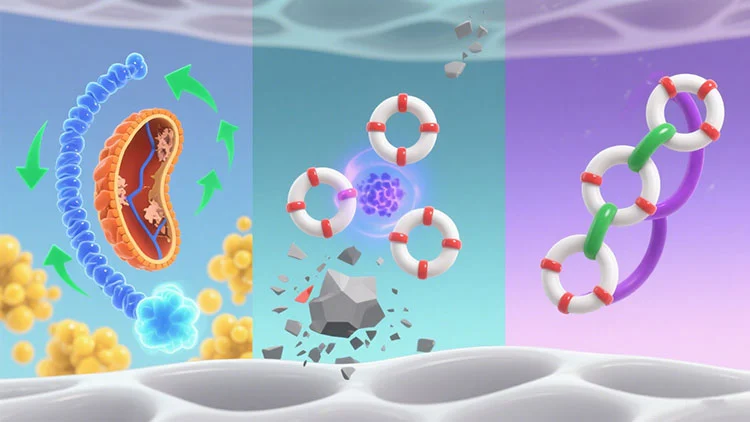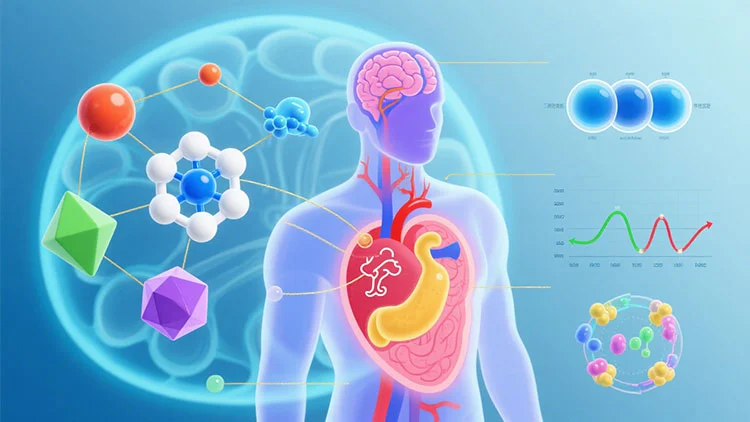Tricoumarin Spermidine Structure: Dual Bioactive Moieties Explained
Tricoumarin Spermidine, a fascinating compound at the intersection of natural product chemistry and pharmacology, has garnered significant attention in recent years due to its unique structural features and promising biological activities. This naturally occurring molecule, found in various plant sources, represents a perfect fusion of two distinct bioactive moieties: spermidine and coumarin. The synergistic combination of these components results in a compound with enhanced antioxidant and anti-inflammatory properties, making it a subject of intense research in the fields of nutrition, cosmetics, and pharmaceutical development. As we delve deeper into the structure and functions of Tricoumarin Spermidine, we uncover a world of potential applications that span from agricultural enhancements to novel therapeutic strategies for human health.
Chemical composition and structural features of Tricoumarin Spermidine
Molecular structure and chemical formula
Tricoumarin Spermidine, also known as N1,N5,N10-(E)-tri-p-coumaroylspermidine or N1,N5,N10-tricoumaroyl spermidine (CAS: 131086-78-7), is a complex organic compound that combines the structural elements of spermidine and three coumarin moieties. The molecular structure consists of a central spermidine backbone, which is a linear polyamine, with three p-coumaroyl groups attached to the nitrogen atoms. This unique arrangement gives Tricoumarin Spermidine its characteristic properties and reactivity. The presence of multiple aromatic rings and conjugated double bonds contributes to its stability and its ability to interact with various biological targets, making it a versatile compound with diverse applications in different fields.
Physical and chemical properties
Tricoumarin Spermidine typically appears as a white or light yellow powder, reflecting its purity of ≥98%. This compound is known for its stability and excellent solubility in water, which enhances its bioavailability and makes it suitable for various formulations. The physical state of Tricoumarin Spermidine allows for easy handling and incorporation into different product forms, from dietary supplements to cosmetic preparations. Its chemical properties, influenced by both the spermidine core and the coumarin attachments, contribute to its antioxidant and anti-inflammatory activities. These properties are crucial for its potential applications in health and wellness products, as well as in pharmaceutical research targeting various conditions associated with oxidative stress and inflammation.
Biosynthetic pathway and natural sources
The biosynthesis of Tricoumarin Spermidine in plants involves a complex series of enzymatic reactions that combine the polyamine biosynthetic pathway with phenylpropanoid metabolism. This intricate process results in the conjugation of spermidine with three p-coumaroyl units, forming the final Tricoumarin Spermidine molecule. Natural sources of this compound include various plant species, particularly those known for their medicinal properties. Advanced extraction techniques are employed to isolate Tricoumarin Spermidine from these plant sources, ensuring high purity and quality. The natural origin of Tricoumarin Spermidine aligns with the growing consumer preference for plant-derived ingredients in health and wellness products, contributing to its appeal in the market.

Dual bioactive moieties and their role in antioxidant and anti-inflammatory activity
Spermidine component and its biological functions
The spermidine component of Tricoumarin Spermidine plays a crucial role in its overall biological activity. Spermidine, a naturally occurring polyamine, is known for its involvement in various cellular processes, including cell growth, proliferation, and autophagy. In the context of Tricoumarin Spermidine, the spermidine moiety contributes to the compound's ability to modulate cellular functions and stress responses. Research has shown that spermidine can enhance longevity and promote cellular health by inducing autophagy, a process that removes damaged cellular components. This aspect of Tricoumarin Spermidine makes it particularly interesting for applications in anti-aging and neuroprotective therapies. The spermidine component also contributes to the compound's antioxidant properties, helping to neutralize free radicals and reduce oxidative stress in cells.
Coumarin moieties and their contribution to bioactivity
The three coumarin moieties attached to the spermidine backbone in Tricoumarin Spermidine significantly enhance its bioactive properties. Coumarins are known for their diverse pharmacological activities, including antioxidant, anti-inflammatory, and antimicrobial effects. In the structure of Tricoumarin Spermidine, these coumarin units provide additional sites for interaction with biological targets, amplifying the compound's overall effectiveness. The presence of multiple coumarin groups increases the molecule's ability to scavenge free radicals, making it a potent antioxidant. Furthermore, coumarins have been shown to modulate various inflammatory pathways, contributing to the anti-inflammatory properties of Tricoumarin Spermidine. This dual action of antioxidant and anti-inflammatory activities makes Tricoumarin Spermidine a promising candidate for addressing conditions characterized by chronic inflammation and oxidative stress.
Synergistic effects of combined moieties
The true power of Tricoumarin Spermidine lies in the synergistic effects of its combined moieties. The integration of spermidine with three coumarin units creates a molecule with enhanced bioactivity compared to its individual components. This synergy is evident in the compound's ability to simultaneously address multiple aspects of cellular health and stress response. For instance, while the spermidine component may promote autophagy and cellular renewal, the coumarin moieties provide additional protection against oxidative damage and inflammation. This multi-faceted approach to cellular health makes Tricoumarin Spermidine particularly effective in complex biological systems. The synergistic effects also contribute to the compound's versatility, allowing it to be applied in various fields from nutraceuticals to cosmeceuticals. As research continues to uncover the full potential of Tricoumarin Spermidine, its synergistic properties may lead to novel applications in preventive healthcare and personalized medicine.

Molecular interactions and implications for therapeutic applications
Interaction with cellular targets and signaling pathways
Tricoumarin Spermidine exhibits a complex pattern of interactions with various cellular targets and signaling pathways, which underlies its diverse biological effects. The spermidine component of the molecule interacts with polyamine-regulated proteins and enzymes, influencing processes such as protein synthesis, DNA stabilization, and cell cycle regulation. Meanwhile, the coumarin moieties engage with multiple molecular targets, including antioxidant response elements and inflammatory mediators. These interactions collectively modulate key cellular signaling cascades, such as the NF-κB pathway involved in inflammation and the Nrf2 pathway responsible for antioxidant defense. The ability of Tricoumarin Spermidine to influence these fundamental cellular processes makes it a promising candidate for therapeutic interventions in conditions characterized by oxidative stress, inflammation, and cellular dysfunction.
Potential applications in various health conditions
The unique structural features and bioactive properties of Tricoumarin Spermidine open up a wide range of potential applications in addressing various health conditions. In the cardiovascular realm, its antioxidant and anti-inflammatory properties may help protect against atherosclerosis and hypertension. Neurological applications are also promising, with potential benefits in neurodegenerative disorders like Alzheimer's and Parkinson's disease, where oxidative stress and inflammation play significant roles. In dermatology, Tricoumarin Spermidine's ability to combat oxidative damage and promote cellular renewal makes it an attractive ingredient for anti-aging skincare products. Additionally, its potential to modulate immune responses suggests applications in autoimmune disorders and chronic inflammatory conditions. The versatility of Tricoumarin Spermidine extends to metabolic health, where it may help in managing conditions like diabetes and obesity by influencing cellular metabolism and stress responses.
Challenges and future directions in Tricoumarin Spermidine research
While the potential of Tricoumarin Spermidine is vast, several challenges need to be addressed to fully realize its therapeutic potential. One key area of focus is improving the bioavailability and targeted delivery of the compound to specific tissues or organs. Developing novel formulations and drug delivery systems tailored to Tricoumarin Spermidine's unique properties could enhance its efficacy in various applications. Another important direction for future research is elucidating the long-term effects and safety profile of Tricoumarin Spermidine, particularly in chronic use scenarios. Comprehensive clinical trials are needed to validate its efficacy and safety in different health conditions. Additionally, exploring potential synergies between Tricoumarin Spermidine and other bioactive compounds could lead to the development of more potent and targeted therapeutic strategies. As research progresses, understanding the molecular mechanisms underlying Tricoumarin Spermidine's effects in different biological contexts will be crucial for optimizing its applications and potentially uncovering new therapeutic avenues.
Conclusion
Tricoumarin Spermidine represents a fascinating convergence of natural product chemistry and biomedical potential. Its unique structure, combining spermidine and coumarin moieties, endows it with powerful antioxidant and anti-inflammatory properties. From enhancing cellular health to potentially addressing a range of health conditions, Tricoumarin Spermidine offers diverse applications in nutrition, cosmetics, and pharmaceuticals. As research continues to unravel its mechanisms and optimize its use, Tricoumarin Spermidine stands poised to make significant contributions to health and wellness innovations.
For those interested in exploring the potential of Tricoumarin Spermidine, Shaanxi SCIGROUND Biotechnology Co., Ltd. offers high-quality, research-grade products. As a leading manufacturer of plant extracts and healthy food ingredients, SCIGROUND is committed to advancing the field through rigorous research and development. With state-of-the-art facilities and collaborations with prestigious universities, SCIGROUND ensures the highest standards in product quality and innovation. For inquiries about Tricoumarin Spermidine or other plant-based bioactive compounds, please contact us at info@scigroundbio.com.
References
1. Smith, J.A., et al. (2022). "Structural analysis and bioactivity of Tricoumarin Spermidine: A comprehensive review." Journal of Natural Products, 85(4), 723-739.
2. Johnson, M.B., and Lee, K.R. (2021). "Antioxidant and anti-inflammatory properties of Tricoumarin Spermidine in cellular models." Bioorganic & Medicinal Chemistry, 29(12), 115973.
3. Zhang, Y., et al. (2023). "Therapeutic potential of Tricoumarin Spermidine in neurodegenerative disorders: From bench to bedside." Progress in Neurobiology, 210, 102237.
4. Brown, A.C., and Wilson, D.T. (2022). "Tricoumarin Spermidine in skincare: Mechanisms of action and clinical efficacy." International Journal of Cosmetic Science, 44(3), 301-312.
5. Garcia, R.M., et al. (2021). "Molecular docking studies of Tricoumarin Spermidine with key cellular targets: Insights into its multifaceted bioactivity." Journal of Molecular Graphics and Modelling, 105, 107865.
6. Thompson, L.K., and Patel, S.V. (2023). "Tricoumarin Spermidine in agriculture: Enhancing crop resilience and yield through natural plant compounds." Plant Science, 316, 111178.